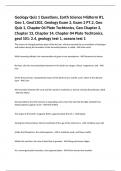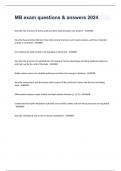Geology Quiz 1 Questions, Earth Science Midterm #1,
Geo 1, Geol1302, Geology Exam 2, Exam 2 PT.2, Geo
Quiz 1, Chapter 04 Plate Techtonics, Geo Chapter 3,
Chapter 13, Chapter 14, Chapter 04 Plate Techtonics,
geol 101: 2.4, geology test 1, oceans test 1
The stream of charged particles given off by the Sun, which prevented the accumulation of hydrogen
and helium during the formation of the terrestrial planets, is called - ANS Solar wind
With increasing altitude, the concentration of gases in our atmosphere - ANS Becomes less dense
By Mass, the four most abundant elements in the Earth are oxygen, silicon, magnesium, and - ANS
Iron
Of the three primary compositional layers of the Earth (Crust, mantle, core), which is the densest
layer - ANS Core
The boundary between the crust and the mantle is marked by a seismic-velocity discontinuity called
- ANS The Moho
Strong evidence that the Universe is expanding comes from the fact that the light emitted from
distant galaxies appears to be - ANS Red-shifted
The shape of the Earth's magnetic field is approximately that of a - ANS Dipole
Among the choices below, the best estimate of the age of the Universe is - ANS 14 billion years old
Unlike the lithosphere, the asthenosphere - ANS Is relatively weak, and flows readily
Within the sea floor, the rate of heat flow is greatest - ANS Along mid-ocean ridges
At a convergent plate boundary, two opposed plates - ANS Move toward one another
,Regions of the sea floor with present day positive magnetic anomalies were formed during times
when the Earth's magnetic field - ANS Had normal polarity
The age of the oceanic crust ____________ with increasing distance from a mid-ocean ridge - ANS
Increases
Marine magnetic anomaly belts (on oceanic basaltic crust) run parallel to - ANS Mid-ocean ridges
Mid-ocean ridges are - ANS Divergent
Earth's geothermal gradient is the rate of temperature change incurred by ____________. - ANS
traversing down within Earth's interior
Earth's surface is protected from solar wind and cosmic radiation by _________. - ANS Earth's
magnetic field
Whereas the crust-mantle boundary represents a change in rock type, the lithosphere-
asthenosphere boundary is due to a change in the _____________ of the material. - ANS rheology
The lithosphere is composed of the ____________. - ANS crust and the uppermost part of the
mantle
Earth's hydrosphere consists of ____________. - ANS surficial freshwater, the oceans, groundwater,
and atmospheric water
With increasing altitude, the concentration of gases in our atmosphere ____________. - ANS
becomes less dense
The rate at which the temperature of the Earth increases with depth is called the
_________________ gradient. - ANS geothermal
As compared to continental crust, the rocks that make up oceanic crust are ____________. - ANS
denser
,Rounded to the nearest integer, the average density of the Earth's crust is __________ grams per
cubic centimeter. (numeric answer only) - ANS 3
That the Earth is a sphereoid is a relatively new discovery, not widely accepted until the 15th
Century when it was confirmed by Columbus's voyage. - ANS False
What is the term for gasses contained within liquid rock beneath the surface of the Earth? - ANS
volatiles
The Earth's mantle is made up mostly of melted peridotite. - ANS false
Which rock composes the Earth's mantle? - ANS peridotite
The shape of Earth's magnetic field is approximately that of a ________. - ANS dipole (such as that
produced by a bar magnet)
The thickness of Earth's crust varies from ____________. - ANS 7 to 70 km
The Moho ____________. - ANS is found deeper underneath continents than under oceans
To the nearest 1000 kilometers, how thick is the Earth's mantle? - ANS
Until Columbus's voyage in 1492, most scientists thought the Earth was much smaller than it actually
is. - ANS False
Continental crust rises higher because it is less _____________ than oceanic crust. - ANS dense
Pluton - ANS A blob-like igneous rock body that has cooled beneath the surface of the Earth is called:
A sheetlike intrusion that lies parallel to surrounding layers of sedimentary rock. - ANS A sill is:
, magma is found beneath the Earth's surface, whereas lava has reached the surface. - ANS The
difference between lava and magma is that:
A sheetlike intrusion that cuts across preexisting layers - ANS A dike is:
All of the above:
Are formed through the freezing of melt
Can be produced at the surface of the Earth as well as deep below the surface
Are the most common types of rocks within Earth - ANS Igneous rocks
True - ANS Very early in Earth's history, it was so hot that the surface was likely entirely molten
Intrusive Igneous Rocks - ANS When magma crystallizes,__________ are formed.
Have a tendency to evaporate and are stable as gases - ANS Volatiles refer to substances that
Decrease - ANS If the volatile content of magma is increased, its viscosity will:
Increase - ANS If a body of magma becomes more felsic, its viscosity will:
Cool and solidify more quickly - ANS As compared to coarse- grained igneous rocks, all fine grained
igneous rocks:
Cool more slowly - ANS All other factors being equal, intrusive rocks that form deep within
Earth_________ than intrusive rocks that cool near the surface.
All of the above:
is volcanic glass
possesses conchoidal fracture
typically is felsic in composition - ANS Obsidian
are lighter in color than mafic rocks. - ANS Most commonly, felsic igneous rocks:





